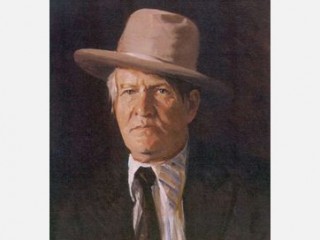
Charles Marion Russell biography
Date of birth : 1864-03-19
Date of death : 1926-10-24
Birthplace : St. Louis, Missouri, USA
Nationality : American
Category : Arts and Entertainment
Last modified : 2011-02-03
Credited as : Artist painter, paintings of cowboys and Indians, Lewis and Clark Meeting the Flathead Indians mural
Charles Marion Russell American painter, left one of the most extensive and accurate pictorial records of the Old West.
Charles Marion Russell was born on March 19, 1864, in St. Louis, Mo., to a comfortable family. As he was hard to control, his parents sent him to military school in Burlington, N.J. In 1880 he left for Montana and for the next twelve years worked as a sheepherder and cowpuncher. In 1888 he spent six months with the Blood Indians in the Northwest Territory. All the while, he drew and painted, seldom selling his work, more often giving it away.
Starting in 1890-1891 in Lewiston, Mont., Russell began to sell his paintings; he also executed a mural for a bank there for which he received $25—the most money he had ever earned for a single work. In 1891 a bartender in Great Falls, Mont., contracted for all of Russell's work. The following year he ceased riding the range.
In 1896 Russell married, and in 1903 he established his studio in Great Falls. That year he went to New York City to sell some of his paintings. As a result of the trip, his pictures were published in McClure's, Leslie's Illustrated Weekly, and other magazines. By 1906 he was known throughout Montana, and his work was featured in the Mint in Great Falls, an old-time saloon that functioned as a museum. Russell's first major show in New York was held in 1911. By the early 1920s he was so successful that a single small painting could fetch a price of over $10,000. He was also a gifted writer, and his Rawhide Rawlins Stories are among the finest sagas in western literature. He died in Great Falls on Oct. 24, 1926.
Russell vividly caught the blood-stirring action of the Old West in his paintings of Native American war parties, brawling cowboys, Native American buffalo hunts, and bucking broncos. A Tight Dally and a Loose Lattice (1920) depicts the movement called the dally: the half hitch a cowboy took around his saddle horn after lassoing a steer. Loops and Swift Horses Are Surer than Lead (1916) portrays cowboys lassoing a bear which was chasing a pack of horses. In the Holdup (1899) Russell memorialized the last crime of the notorious outlaw Big Nose George—the holdup of a stagecoach. When Horse Flesh Comes High (1909) pictures a posse charging two outlaws who fire while crouching behind their horses.
Russell also executed many small bronze sculptures of cowboys, Native Americans, and animals and modeled a few small groups in wax. One of these, the Poker Game (ca. 1893), depicts a Chinese person, a cowboy, and a Native American sitting on the grass around a blanket on which the cards are placed.
















